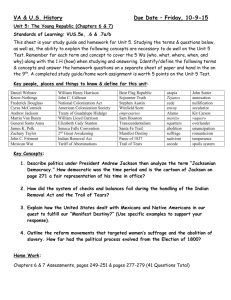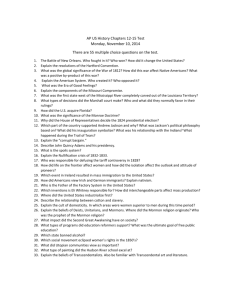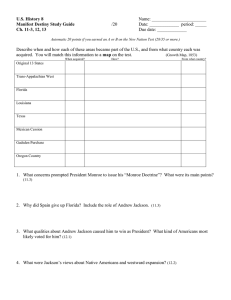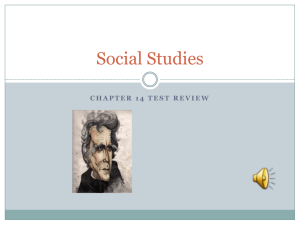NG - Bekemeyer's World
advertisement
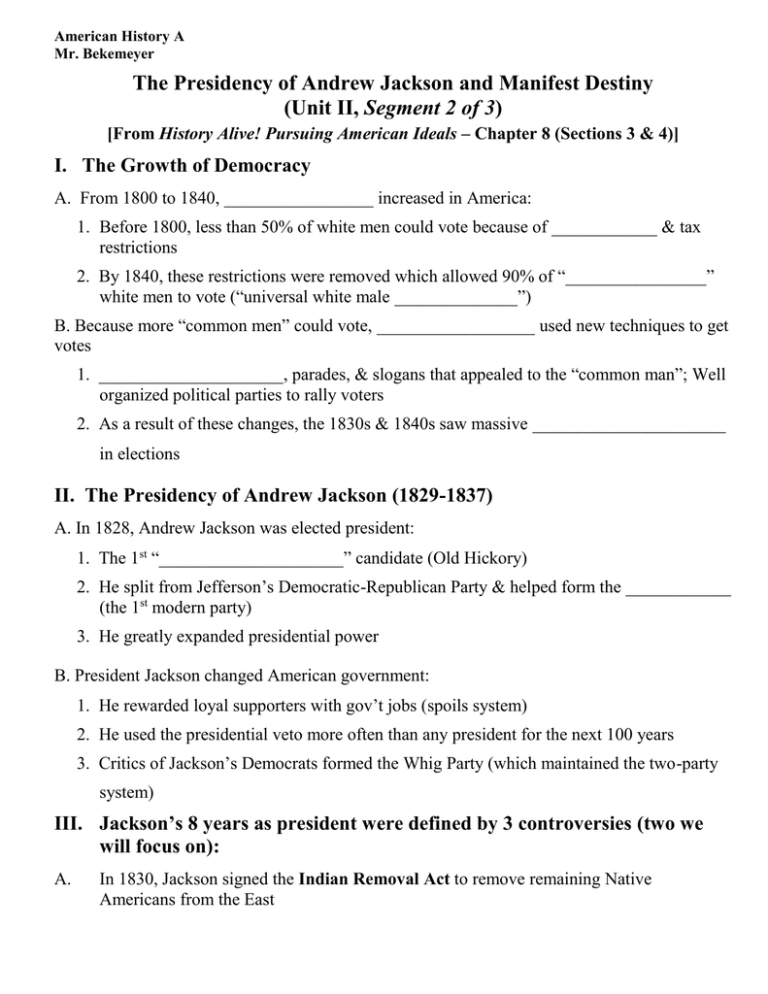
American History A Mr. Bekemeyer The Presidency of Andrew Jackson and Manifest Destiny (Unit II, Segment 2 of 3) [From History Alive! Pursuing American Ideals – Chapter 8 (Sections 3 & 4)] I. The Growth of Democracy A. From 1800 to 1840, _________________ increased in America: 1. Before 1800, less than 50% of white men could vote because of ____________ & tax restrictions 2. By 1840, these restrictions were removed which allowed 90% of “________________” white men to vote (“universal white male ______________”) B. Because more “common men” could vote, __________________ used new techniques to get votes 1. _____________________, parades, & slogans that appealed to the “common man”; Well organized political parties to rally voters 2. As a result of these changes, the 1830s & 1840s saw massive ______________________ in elections II. The Presidency of Andrew Jackson (1829-1837) A. In 1828, Andrew Jackson was elected president: 1. The 1st “_____________________” candidate (Old Hickory) 2. He split from Jefferson’s Democratic-Republican Party & helped form the ____________ (the 1st modern party) 3. He greatly expanded presidential power B. President Jackson changed American government: 1. He rewarded loyal supporters with gov’t jobs (spoils system) 2. He used the presidential veto more often than any president for the next 100 years 3. Critics of Jackson’s Democrats formed the Whig Party (which maintained the two-party system) III. Jackson’s 8 years as president were defined by 3 controversies (two we will focus on): A. In 1830, Jackson signed the Indian Removal Act to remove remaining Native Americans from the East 1. Jackson faced a problem with Native Americans in the American South: a. Gold was discovered in north Georgia in 1828 in lands controlled by the Cherokee who refused to move from GA b. Jackson asked Congress for the Indian Removal Act of 1830 to relocate Native Americans across the ______________________ River 2. In 1838, the U.S. Army forced the ____________ west on the “_________________” B. The Nullification Crisis (1832-33) exposed sectionalism between the states & national government 1. By the 1830s, _________________________ was becoming more obvious, especially over the issue of _______________: a. Southerners argued that tariffs helped Northern industry but made prices higher for farmers b. When Congress passed a high tariff in 1832, Southerners claimed “______________” & threatened to nullify the tariff c. ____________________ is the argument that states have the right to ignore federal laws that they think are unfair 2. President Jackson viewed nullification as a 3. VP John C. Calhoun from South Carolina threat to the U.S. urged nullification a. The national gov’t is supreme over the states. b. Urged Congress to pass the Force Bill to enforce the tariff a. States have the right to protect themselves from the national government b. As a last resort, states can secede from the Union 4. In 1833, Congress created a compromise tariff & the crisis ended 5. Significance of Nullification Crisis: a. Revealed _____________________between North & South; South used “states’ rights” to argue that secession was possible b. President Jackson was willing to use force to protect the power of the national gov’t over the states 6. Jackson was criticized as ____________________ his Constitutional powers as president IV. Conclusions—Andrew Jackson represented a new era in American democracy: A. Forming the Democratic Party, campaigning for the votes of the “common man,” & spoils system B. Jackson’s use of the veto strengthened presidential power C. Opposition to Jackson led to the permanent two-party political system Image Analysis Examine the image on the next slide & answer these questions: 1. What point might the artist be making about the American West? 2. What type of American traveled West? Was this an easy journey? 3. Why would Americans make the journey into the West? Primary Source Analysis Use the following primary sources (on Mr. B’s slides) to answer these questions: 1. What do the terms “manifest” & “destiny” mean? 2. What were the perceived benefits of this westward expansion? 3. How did Americans justify their westward expansion? Manifest Destiny In the 1840s, _________________________ led Americans to acquire all lands from the Atlantic to the Pacific in a movement called Manifest Destiny Americans flooded into the West for new economic opportunities The U.S. gained Texas, Oregon, California, & other territories through treaty or war Motivations for Westward Expansion The journey West was __________________ & unpredictable, yet thousands of Americans traveled along the Oregon, Santa Fe, & Mormon Trails The earliest pioneers were fur traders, land speculators, & poor farmers looking for ________________________ Soon, farmers, miners, ranchers, & religious groups flooded West Reasons for Manifest Destiny Changes in the early Antebellum era (1800-1840), encouraged westward expansion in the 1840s Jefferson’s ___________________________ doubled the size of the USA Lewis & Clark’s exploration confirmed the economic potential of the western territory The growth of “___________________” & commercial farming led to a desire for more western lands Improved ________________________ such as canals, steamboats, & railroads increased speed & profitability The U.S. population grew 300% The number of U.S. states grew from 13 to 26 Western state populations exploded (Ohio’s population grew from 50,000 to 1.5 million Native American Relations Westward expansion brought conflict with Native Americans, such as the _________________ War, as trails disrupted hunting grounds & violated previous treaty agreements The Treaty of ____________________ created a vast Indian Territory but was repeatedly ignored by whites expanding West What is Manifest Destiny? Examine the image by John Gast called American Progress, on the next slide & answer the following questions: 1. Identify 3 reasons Americans moved West. 2. Identify 3 consequences of American westward expansion. 3. What does the women in the center of the image represent? 4. What point is the artist trying to make with his use of light? Westward Trails The Oregon Trail -- Led thousands of _____________ to the fertile lands of Oregon in the 1840s The Santa Fe Trail -- Allowed the U.S. to sell goods to _________________ The Mormon Trail -- In 1830, Joseph Smith founded the Mormon Church of Latter-day Saints in New York, but were persecuted & forced to move West; Joseph Smith’s murder forced new LDS leader Brigham Young to resettle in Salt Lake, Utah where he built a Mormon community What was the journey west across the Oregon Trail like? Use three adjectives (or descriptive words) to describe pioneer experiences on the Oregon Trail. 1. Adjective #1 _______________________________ Why? 2. Adjective #2 _______________________________ Why? 3. Adjective #3 _________________________ Why?

